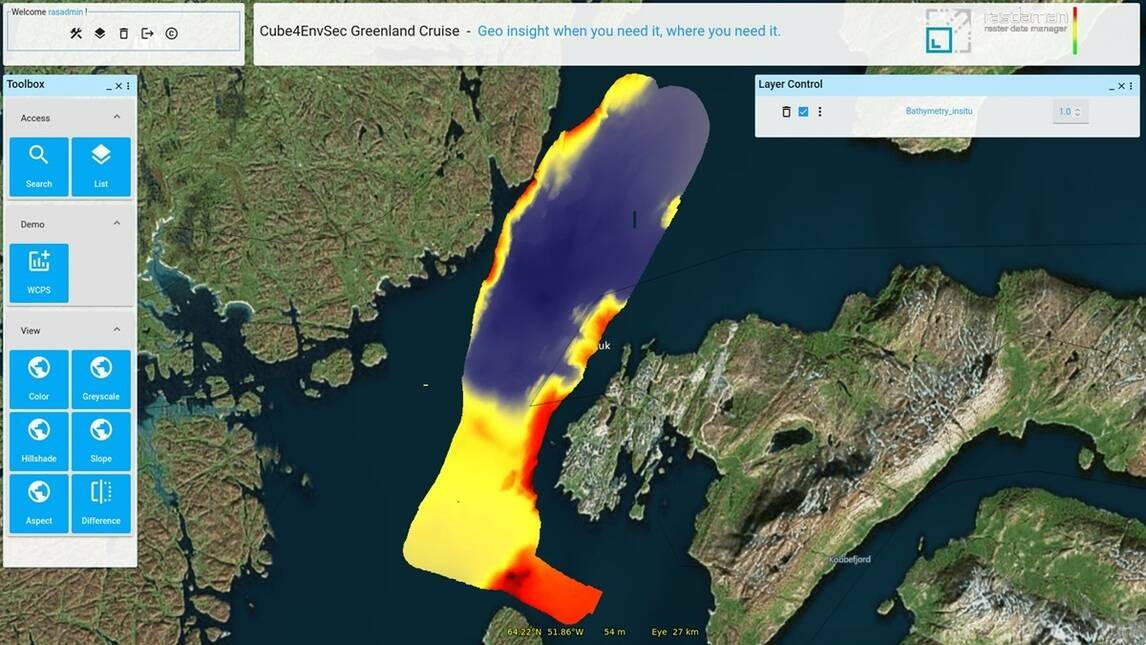In mid-April the research vessel "Sanna" has explored Greenland's coastal underwater landscape while being connected to the EarthServer datacube federation.
Federation members worldwide were able to use realtime bathymetry data, and on board the federation holdings – satellite, weather, bedrock, and more datacubes – were readily available to the scientists for analysis while still on board.
Sanna is a state-of-the art research vessel operated by the Greenland Institute of Natural Resources (GINR). In a demonstration conducted jointly by GINR and Constructor University as part of NATO´s Science for Peace and Security (SPS) project Cube4EnvSec, Sanna showed the way forward in seamlessly interconnected services, including on-the-fly data homogenization and intercontinental distributed data fusion, all fully automated. Cube4EnvSec has set out to demonstrate the added value of federated, AI-enabled datacube services for planetary-scale joint use of Big Earth Data.
“We routinely harvest from worldwide data sources into datacubes – you wouldn’t believe how heterogeneous their data are, and how much the mileage of metadata completeness and conformance varies”, explains Prof. Dr. Peter Baumann, coordinator of Cube4EnvSec. “Main task of our rasdaman datacube engine is to push all technicalities behind the curtain and give support, such as with AI-Cube chatbots, so that experts gain productivity and non-experts first time get access.”
The seas and fjords around Greenland and neighbouring countries are of vital economic and ecological importance. Fishing for shrimp and Greenland halibut is Greenland's dominant industry, and the submarine slopes and canyons are hotspots for marine biodiversity, some of which is fragile. The terrain below the sea surface is an important factor. The integration of highly dynamic marine data into high-performance maritime data services remains a challenge. For powerful support of mariners during navigation in general, these maritime data need to be combined with environmental data like sea floor properties, water temperature, currents, waves, and ice conditions. For scientific and fishery further relevant parameters such as plankton blooms, sea surface temperature, etc. need to be integrated in their most up-to date version from various and diverse sources.
In Cube4EnvSec, the participants Constructor University, Tel Aviv University, GINR, and Istanbul Aydin University are building a datacube federation of 3D x/y/t and 4D x/y/z/t datacubes on forecast, nowcast, and historical data updated automatically from a variety of sources. Datacubes offered include radar and optical satellite data, derived products for environmental monitoring and aviation-safety (such as wind, clouds, and volcanic ash), consolidated observations on global lightning occurrences, and more. This is federated, among others, with EarthServer and EO-Cube, the IEEE GRSS Earth datacube service in the US.
GINR is collaborating with the international network of the Arctic Pilot where further datacubes are planned to be added soon. “Specifically for Greenland, it is important to have terrain characteristics such as slope, aspect, and ruggedness, ready for mix & match with a variety of other data”, said Karl Zinglersen, head of department Environment at GINR.
Research vessel “Sanna” is operating in the fjords and offshore waters of East Greenland in the Denmark Strait. Marine scientists on board are investigating Blue Carbon flux properties of the ocean, and biomass health and ocean pollution to assess impacts from climate change and industrial environment. Their sampling relies on supporting information obtained from satellites, in-situ data, AI models and spatio-temporal analytical capabilities which in future can be offered in a standards-compliant way through the rasdaman datacube services.

Subscribe to our newsletter
Stay updated on the latest technology, innovation product arrivals and exciting offers to your inbox.
Newsletter

